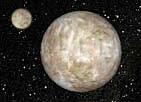
Artistic impression of Orcus.
Orcus is a trans-Neptunian object in the Kuiper belt with a large moon. It was discovered on February 17, 2004 by Michael Brown of Caltech, Chad Trujillo of the Gemini Observatory, and David Rabinowitz of Yale University. Precovery images as early as November 8, 1951 were later identified. It is believed to be a dwarf planet by some astronomers,and it is massive enough to be considered one under the 2006 draft proposal of the IAU.Orcus is a plutino, locked in a 2:3 resonance with Neptune, making two revolutions around the Sun, while Neptune makes three. This is much like Pluto, except that it is constrained to always be in the opposite phase of its orbit from Pluto: Orcus is at aphelion when Pluto is at perihelion and vice versa. Because of this, along with its large moon Vanth that recalls Pluto's large moon Charon, Orcus has been seen as the anti-Pluto. This was a major consideration in selecting its name, as the deity Orcus was the Etruscan equivalent of the Roman Pluto, and later became an alternate name for Pluto. Orcus is In the magnitude and size estimates reported above it was assumed that Orcus is a singular object. The presence of a relatively large satellite (Vanth, see below) may change them considerably. The absolute magnitude of Vanth is estimated at 4.88, which means that it is about 11 times fainter than Orcus itself. If the albedos of both bodies are the same at 0.27 then the size of Orcus is about 810 km, while the size of Vanth is about 270 km. If, however, the albedo of Vanth is only 0.12—typical for small reddish Kuiper belt objects, their sizes are approxima
tely 760 and 380 km, respectively.
Terraforming[]

Artist conception of Orcus and Vanth. Vanth could easily be 1/3 to 1/2 the diameter of Orcus
Orcus is probably large enough to be terraformed, along with its moon, Vanth. Orcus is about the size of Ceres, or a bit larger. Orcus would be very difficult to terraform because of its distance from the Sun. Orcus also has very low gravity. Orcus can be terraformed by sending a probe that would land on one of Neptune's irregular moons, such as Psamathe. Psamathe can be the new "spacecraft" to go to Orcus. We would have to send a fusion reactor to Psamathe. The fusion will melt its way inside of Psamathe. Psamathe will be like a controlled spacecraft. Psamathe would be moved out of the orbit of Neptune, and be melted on its way to Orcus. Psamathe would then land on Orcus and the heating probe that is inside the 'spacecraft' will still have a lot of heating source left. The probe would then drill its way into Orcus' center. The probe would then become a hot core. Orcus will now have a slight atmosphere and after 10 years it will have a thick atmosphere. 30 years later it will have an earthlike atmosphere. We could make Orcus orbit Neptune too, providing more light, energy and protection from the kuiper belt asteroids.